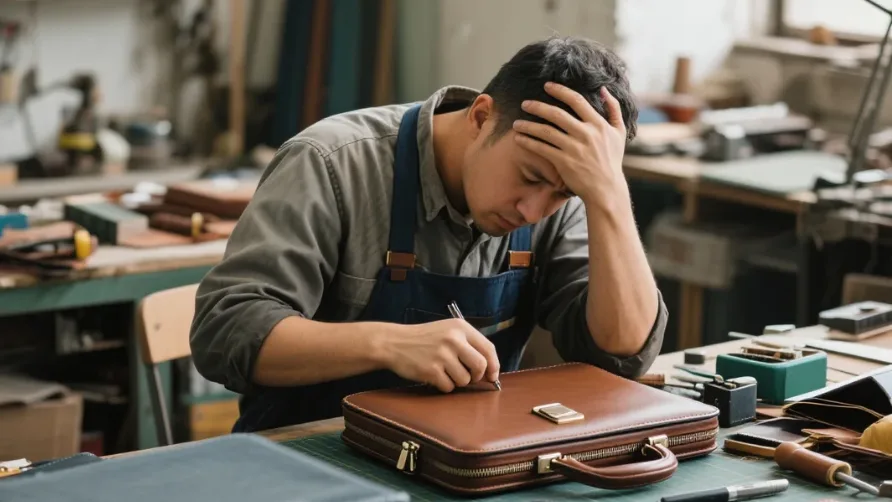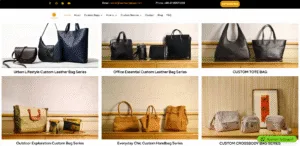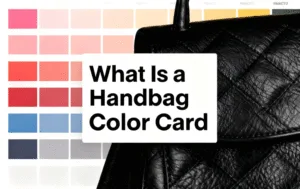In today’s competitive business landscape, more briefcase branding are choosing custom briefcases as practical and impactful tools for corporate gifting, branded merchandise, and employee use. A well-designed briefcase reflects professionalism and helps reinforce brand identity in daily business scenarios.
However, without the right strategy, poor design, low-quality materials, or delays in production can do more harm than good. That’s why partnering with reliable custom briefcase suppliers is critical. Businesses looking for flexible solutions often seek custom briefcases with low minimum order quantities or work with a specialized custom briefcases manufacturer to ensure consistency, quality, and brand alignment.
Done right, wholesale custom briefcases are more than a giveaway—they become a lasting extension of your brand.
Contents
- 1 Mistake 1: Custom Briefcase Branding Ignoring Target Audience Needs
- 2 Mistake 2: Poor Material Choices for Wholesale Custom Briefcase
- 3 Mistake 3: Overcomplicating the Design for Bulk Custom Briefcase
- 4 Mistake 4: Not Considering Manufacturing Feasibility
- 5 Mistake 5: Skipping Quality Control and Feedback Loops
- 6 Conclusion:
Mistake 1: Custom Briefcase Branding Ignoring Target Audience Needs

A frequent mistake companies make when ordering custom briefcases is overlooking who the actual users are. Is the briefcase meant for senior executives, sales representatives, everyday employees, or valued clients? Each group has distinct needs. Executives may prefer premium leather finishes with minimalist styling, while sales teams need lightweight bags with multiple compartments for documents and devices. Without understanding the target audience, brands risk selecting designs that lack relevance and appeal. Even when partnering with an experienced custom briefcases manufacturer, failure to define the end-user can lead to missed expectations, unnecessary features, and wasted investment. For businesses prioritizing sustainability, working with a custom briefcase supplier that offers options like custom briefcases made from recycled ocean plastic can also be an advantage—especially when aligning product values with user values.
Result:
Low usage, poor practicality, and weak brand exposure due to a mismatch between design and user expectations.
Suggestion:
Start with clear audience profiling. For flexibility, consider suppliers offering custom briefcases with low minimum order quantities to test different versions before scaling up.
Mistake 2: Poor Material Choices for Wholesale Custom Briefcase

To reduce costs, some businesses opt for cheap or low-grade materials when ordering custom briefcases. While this might seem budget-friendly upfront, it often results in briefcases that look and feel unprofessional—something no brand wants associated with its image. Materials like low-quality PU or imitation leather tend to crack, peel, or deform over time, especially under regular use. This not only shortens the product’s lifespan but also reflects poorly on the company behind it. Whether working with overseas partners or sourcing custom briefcases made in the USA, it’s crucial to prioritize material integrity. A reliable custom briefcases manufacturer or custom briefcase supplier will offer a range of high-quality materials, including full-grain leather, premium vegan leather, or durable PU, some of which may even support eco-certifications like custom briefcases made from recycled ocean plastic. The choice of material speaks directly to the perceived value of your brand.
Result:
Cracking, peeling, and poor durability reduce both product life and brand credibility.
Suggestion:
Invest in sturdy, high-quality fabrics and highlight features like sustainability or longevity. If unsure, start with a custom briefcase’s low minimum order to evaluate options before scaling.
Mistake 3: Overcomplicating the Design for Bulk Custom Briefcase

In the pursuit of visibility, some brands tend to overdesign their custom briefcases—placing oversized logos, using clashing color schemes, or adding excessive features that don’t align with user needs. While the intention is to make the brand stand out, the result is often the opposite: cluttered, impractical briefcases that feel promotional rather than professional. This is particularly problematic in B2B contexts, where users (such as clients or employees) may prefer subtle elegance over loud branding. A complicated design can also lead to production inefficiencies, higher defect rates, or increased costs—especially when working with custom briefcase manufacturers who need clear technical specs. When creating products with custom briefcase suppliers, it’s important to balance branding with usability. A clean layout, neutral base color, and premium feel are far more likely to resonate across a wide range of users. Whether you’re sourcing from overseas or opting for custom briefcases made in the USA, the goal should be subtle brand integration that enhances, not overwhelms, the design. Smart design touches—such as a debossed logo on the lining, a metal nameplate, or logo-engraved zipper pulls—can be far more effective in reinforcing brand identity.
Result:
Visually overwhelming and functionally confusing briefcases lead to low user adoption. They fail to convey the intended brand message and may end up unused or discarded.
Suggestion:
Adopt a clean, thoughtful approach. Work with your custom briefcases manufacturer to incorporate refined branding elements. If you’re experimenting, try a custom briefcases low minimum order option to test what design your audience responds to best. For sustainable-focused brands, consider including custom briefcases made from recycled ocean plastic—it speaks to modern values and adds quiet credibility.
Mistake 4: Not Considering Manufacturing Feasibility

One of the most underestimated mistakes when developing custom briefcases is creating an overly idealized design without considering whether it can actually be manufactured at scale. Brands often focus too heavily on aesthetics or unique features without consulting technical experts, resulting in specifications that are either structurally unrealistic or too expensive to produce. This leads to endless revisions, delays in sampling, and extended production timelines. According to a 2023 survey by Global Manufacturing Insights, over 38% of custom bag orders are delayed due to unclear or unfeasible design specifications.
So, how can you avoid turning a creative idea into a costly mistake?
Start by involving your custom briefcases manufacturer early in the development process. A professional custom briefcase supplier with OEM/ODM experience can help assess structural integrity, material behavior, and production capabilities before sampling begins. This step is especially critical when ordering from certified facilities that follow global standards, such as BSCI-compliant briefcase manufacturers, where approval and lead time cycles are tightly managed. Whether you’re producing overseas or sourcing custom briefcases made in the USA, early feasibility checks will save time and reduce cost risk in the long run.
Result:
Designs get revised multiple times, pushing back delivery timelines and increasing sampling and development costs.
Suggestion:
Collaborate early with manufacturers who offer OEM/ODM services. Consider starting with a custom briefcase low minimum order to test feasibility. A skilled supplier can strike the right balance between creativity and practicality—turning your vision into a scalable, premium product.
Mistake 5: Skipping Quality Control and Feedback Loops

Even with a solid design, premium materials, and a capable custom briefcase manufacturer, many brands make the critical mistake of rushing into mass production without thoroughly testing samples or gathering user feedback. This often happens after finalizing visuals and specifications that look great on paper but haven’t been validated in real use. As we’ve seen in previous sections, each step—design, material, feasibility—builds on the last. But skipping the final quality and feedback phase can compromise the entire investment.
No matter how attractive your custom briefcases may seem, flaws in durability, zipper performance, strap comfort, or internal layout often go unnoticed until products hit the market. By then, it’s too late. Bulk orders become liabilities. Customer complaints rise, returns increase, and brand credibility takes a hit.
According to industry data from Bag & Travel Goods Association (BTGA), 52% of bulk bag complaints in 2023 stemmed from issues that could have been avoided with proper pilot testing and feedback collection. The risk is even greater for brands ordering bulk custom briefcases or launching with a new custom briefcase supplier under tight timelines.
Result:
Without sample testing and end-user validation, brands may face costly after-sales issues, damaged reputation, and wasted inventory—especially in wholesale custom briefcases programs or larger B2B distribution.
Suggestion:
To avoid these setbacks, implement a small-scale trial process. Many custom briefcases manufacturers and custom briefcase suppliers now offer custom briefcases low minimum order options, allowing brands to run limited production batches for field testing. Engage real users—employees, sales reps, or clients—to gather feedback on size, comfort, functionality, and perceived value. This process helps identify weak points and adjust the final design accordingly.
If you’re exploring custom briefcases USA or sourcing from certified custom briefcase manufacturers, ask about their internal QC processes and customer approval stages. For brands focused on sustainability, testing custom briefcases made from recycled ocean plastic is equally important to evaluate performance under real-world conditions.
Ultimately, how to choose the best custom briefcases isn’t just about aesthetics—it’s about usability, consistency, and long-term satisfaction. Whether you’re ordering custom briefcases wholesale, launching a corporate line, or sourcing wholesale custom briefcase gifts for VIP clients, the smartest brands always validate before scaling.
Don’t just hope for the best—test, refine, and then go big. That’s how great custom briefcases are built.
Conclusion:
In today’s competitive market, custom briefcases are more than just practical accessories—they are extensions of your brand’s professionalism and identity. However, overlooking your target audience, choosing inferior materials, overcomplicating designs, ignoring manufacturing feasibility, or skipping quality control can severely undermine your branding efforts.
To ensure success, focus on these key points:
-
Clearly define your target users and design briefcases suited to their real-world needs.
-
Prioritize durable and sustainable materials to enhance both usability and brand value.
-
Keep designs clean and professional, avoiding overbranding while balancing functionality and aesthetics.
-
Partner with experienced custom briefcase manufacturers or suppliers who offer OEM/ODM services to guarantee efficient production.
-
Implement quality control and feedback loops by starting with custom briefcases low minimum order trials to refine before scaling.
Whether for corporate gifts, employee essentials, or client giveaways, a high-quality, well-tested custom briefcase becomes a lasting symbol of trust and professionalism.
Take action today—start small with low minimum orders, collaborate with reliable custom briefcase suppliers, and turn each briefcase into a powerful brand ambassador.






